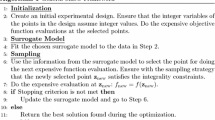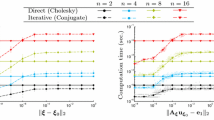Abstract
Surrogate-based optimization has become a major field in engineering design, due to its capacity to handle complex systems involving expensive simulations. However, the majority of general-purpose surrogates (also called metamodels) are restricted to continuous variables, although versatile problems involve additional types of variables (discrete, integer, and even categorical to model technological options). Therefore, the main contribution of this paper consists in the development of metamodels specifically dedicated to handle mixed variables, in particular continuous and unordered categorical variables, and their comparison with state-of-the-art approaches. This task is performed in three steps: (i) considering an appropriate parametrization (integer mapping, regular simplex, dummy, effect codings) for the mixed variable design vector; (ii) defining metrics to compare pairs of design vectors; (iii) carrying out an ordinary or moving least square regression scheme based on the parametrization and metric previously defined. The proposed metamodels have been tested on six analytical benchmark test cases, and applied to the structural finite element analysis model of a rigid frame characterized by continuous and categorical variables. In particular, it is demonstrated that using a standard regular simplex representation for the nominal categorical variables usually outperforms a direct conversion of the nominal parameters to integer values, while offering an efficient and systematic way to encompass all types of variables in a common framework. It is also shown that the choice of a given variable representation has a higher impact on the results than the selected scheme (ordinary or moving least squares), or than the metric used for calculating distances between samples.













Similar content being viewed by others
Notes
The terms “low-fidelity” and “high-fidelity” originate from the field of multi-level optimization, where models with different levels of accuracy or confidence are used within an integrated optimization process. In the context of this paper, “low-fidelity” thus refers to the metamodels, while “high-fidelity” refers to the exact function (i.e. the analytical function, or the finite element model).
References
Abhishek K, Leyffer S, Linderoth JT (2010) Modeling without categorical variables: a mixed-integer nonlinear program for the optimization of thermal insulation systems. Optim Eng 11:185–212
Abramson M, Audet C, Chrissis JW, Walston JG (2009) Mesh adaptive direct search algorithms for mixed variable optimization. Optim Lett 3:35–47
Agresti A (1996) An introduction to categorical data analysis. Wiley, New York
Ahmad A, Dey L (2007) A method to compute distance between two categorical values of same attribute in unsupervised learning for categorical data set. Pattern Recognit Lett 28(1):110–118
Aiken LS, West SG, Reno RR (1991) Multiple regression: testing and interpreting interactions. Sage, Thousand Oaks
Bandler JW, Koziel S, Madsen K (2008) Editorial–surrogate modeling and space mapping for engineering optimization. Optim Eng 9:307–310
Bar-Hen A, Daudin JJ (1995) Generalization of the Mahalanobis distance in the mixed case. J Multivar Anal 53:332–342
Boriah S, Chandola V, Kumar V (2008) Similarity measures for categorical data: a comparative evaluation. In: Proceedings of the 2008 SIAM international conference on data mining, Atlanta, Georgia, 24–26 April
Breitkopf P, Filomeno Coelho R (eds) (2010) Multidisciplinary design optimization in computational mechanics. ISTE/Wiley, Chippenham
Breitkopf P, Rassineux A, Villon P (2002) An introduction to moving least squares meshfree methods. Rev Eur Éléments Finis 11(7–8):825–867
Ferreira AJM (2009) MATLAB codes for finite element analysis: solids and structures. Solid mechanics and its applications. Springer, Berlin
Forrester AIJ, Keane AJ (2009) Recent advances in surrogate-based optimization. Prog Aerosp Sci 45(1–3):50–79
Grossmann IE (2002) Review of nonlinear mixed-integer and disjunctive programming techniques. Optim Eng 3:227–252
Hemker T (2008) Derivative free surrogate optimization for mixed-integer nonlinear black box problems in engineering. PhD thesis, Technischen Universität Darmstadt, Germany
Kokkolaras M, Audet C, Dennis DE Jr (2001) Mixed variable optimization of the number and composition of heat intercepts in a thermal insulation system. Optim Eng 2:5–29
Lancaster P, Salkauskas K (1981) Surfaces generated by moving least squares methods. Math Comput 37(155):141–158
Li R, Emmerich MTM, Bäck T, Eggermont J, Dijkstra J, Reiber JHC (2009) Radial basis function neural networks for metamodeling and optimization in mixed integer spaces. Lorentz Center Optimizing Drug Design, Leiden University
Liao T, Montes de Oca MA, Stützle T (2011) Tuning parameters across mixed dimensional instances: a performance scalability study of Sep-G-CMA-ES. In: Proceedings of the workshop on scaling behaviours of landscapes, parameters and algorithms of the genetic and evolutionary computation conference (GECCO 2011), Dublin, Ireland, 12–16 July, pp 703–706
Lindroth P (2011) Product configuration from a mathematical optimization perspective. PhD thesis, Chalmers University of Technology, Gothenburg, Sweden
Mahalanobis PC (1936) On the generalized distance in statistics. In: Proceedings of the National Institute of Sciences of India, vol 2, pp 49–55
McCane B, Albert MH (2008) Distance functions for categorical and mixed variables. Pattern Recognit Lett 29(7):986–993
Meckesheimer M, Barton RR, Simpson T, Limayem F, Yannou B (2001) Metamodeling of combined discrete/continuous responses. AIAA J 1950–1959 (American Institute of Aeronautics and Astronautics)
Nayroles B, Touzot G, Villon P (1992) Generalizing the finite element method: diffuse approximation and diffuse elements. Comput Mech 10:307–318
Papadrakakis M, Lagaros ND, Plevris V (2005) Design optimization of steel structures considering uncertainties. Eng Struct 27:1408–1418
Park J, Sandberg IW (1991) Universal approximation using radial basis function networks. Neural Comput 3:246–257
Racine JS, Li Q (2004) Nonparametric estimation of regression functions with both categorical and continuous data. J Econom 119(1):93–130
Liew RJY, Chen H, Shanmugam NE, Chen WF (2000) Improved nonlinear plastic hinge analysis of space frame structures. Eng Struct 22(10):1324–1338
Schuëller GI, Jensen HA (2008) Computational methods in optimization considering uncertainties—an overview. Comput Methods Appl Mech Eng 198(1):2–13
Senin N, Wallace DR, Borland N, Jakiela M (1999) Distributed modeling and optimization of mixed variable design problems. Tech rep TR 9901, MIT CADlab
Sun C, Zeng J, Pan JS (2011) A modified particle swarm optimization with feasibility-based rules for mixed-variable optimization problems. Int J Innov Comput Inf Control 7(6):3081–3096
Wilson DR, Martinez TR (1997) Improved heterogeneous distance functions. J Artif Intell Res 6:1–34
Acknowledgements
The author is grateful to Innoviris (Brussels-Capital Region, Belgium) for its support under a BB2B project entitled “Multicriteria optimization with uncertainty quantification applied to the building industry”. The author is also grateful to the Editor and Reviewer’s fruitful comments and suggestions.
Author information
Authors and Affiliations
Corresponding author
Rights and permissions
About this article
Cite this article
Filomeno Coelho, R. Metamodels for mixed variables based on moving least squares. Optim Eng 15, 311–329 (2014). https://doi.org/10.1007/s11081-013-9216-8
Received:
Accepted:
Published:
Issue Date:
DOI: https://doi.org/10.1007/s11081-013-9216-8




